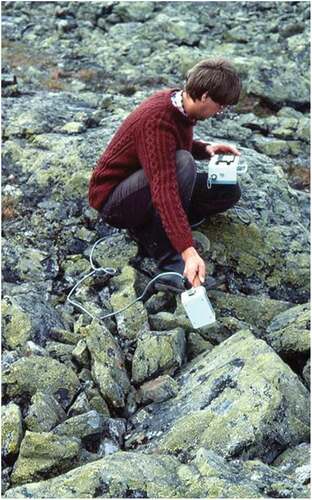It is with great sadness that we report the death of Professor Ted Milton ().
Figure 1. Ted hiking in the Picos De Europa mountains in northern Spain in 2017 (photograph courtesy of Stephanie Milton)
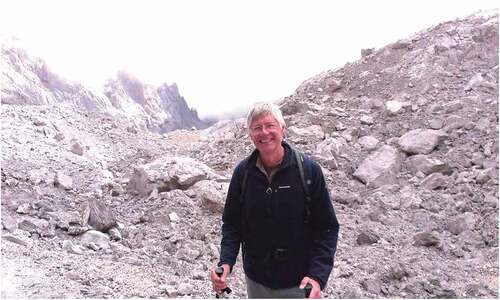
Ted graduated with a BSc in Geography from the University of Exeter in 1975. Following a VSO (Voluntary Service Overseas) year in Nigeria, he read for a PhD in Geography at the University of Reading, graduating in 1982. As part of his PhD Ted designed and built what was to be a prototype of his Milton Multiband Radiometer (MMR), which he used to determine the spectral properties of terrain in southern Italy. The MMR was one of the first portable multiband radiometers and was designed to measure surface reflectance in wavebands used by airborne and spaceborne sensors of the day (Milton Citation1980, ). Over a hundred of these instruments were produced by Ted and his team, and many are still in use in education and training establishments worldwide.
Following his doctorate, Ted held short term lectureships at the Universities of Reading and Durham before joining the University of Southampton in 1981 where he was appointed as the Science Faculty Lecturer in Remote Sensing, based in the Department of Geography. Although a geographer by background, Ted’s interests in physics and technology led him to focus on remote sensing as a means of making quantitative measurements of the Earth and its atmosphere. Ted was always looking to apply remote sensing techniques to many different and interesting areas of science and in doing so, he built strong interdisciplinary links at home and abroad. From the outset Ted was also interested in applying remote sensing to real world problems and throughout his career he worked on a wide range of applied remote sensing projects. This led to him becoming one of the co-founders of the GeoData Institute (an environmental consultancy based in the Geography Department) in 1984.
Ted will be well known by many in the remote sensing community for his work in field spectroscopy. His early review paper ‘Principles of Field Spectroscopy’ (Milton, Citation1987) laid the foundation for much of his future research. In the late 1980s, field spectroscopy was an emerging technique in remote sensing with foundations in experimental physics, yet Ted rightly identified field spectroscopy as a ‘technique of fundamental importance in remote sensing’ whose ‘potential is rarely exploited’ (Milton, Citation1987: 1807). In this seminal piece, Ted outlined how field spectroscopy has the capacity to bridge the gap between laboratory and field situations, calibrate sensors, inform spectral band choice and test biophysical models. Those ideas formed the basis of an emerging area of quality assurance in Earth observation.
Ted’s research into calibration and validation led to several highly acclaimed peer-reviewed papers that still have currency today. For example, his 1999 paper with Dr Geoff Smith on the empirical line method has been cited over 600 times, with nearly 30 citations in 2021 alone (Smith and Milton Citation1999). This paper exemplifies Ted’s ability to get to the essence of a problem and derive an explanation and a viable solution for remote sensing practitioners.
In 1988, Ted established the Natural Environment Research Council (NERC) Equipment Pool for Field Spectroscopy (EPFS) at the University of Southampton. This pioneering facility housed, maintained and calibrated the UK’s publicly owned collection of field spectroradiometers. These expensive and highly sensitive instruments measure the wavelength and amplitude of radiation from blue to mid-inrared wavelengths, and were loaned to researchers across the UK. EPFS also trained scientists, notably PhD students, in field spectroscopy techniques. Many, if not most, UK remote sensing professionals working now would have come into contact with EPFS at some point in their careers. Ted directed and led the facility successfully for fifteen years (1988–2003), during which time it supported over 300 research projects, and was a key part of several high profile airborne remote sensing campaigns, both in the UK and internationally. The facility, now the NERC Field Spectroscopy Facility (FSF), continues its important work from the University of Edinburgh. That the facility still exists and operates in much the same way as originally developed by Ted is a testament to his vision and an important part of his scientific legacy.
Ted’s career was characterized by a series of innovative research projects. One notable example was an airborne experiment involving a hand-held spectrometer which protruded from the port side of the rear passenger cabin of a helicopter. Used to record spectral reflectance data at various heights above vegetation canopies (Milton et al. Citation1994; ), it provided new insights into grassland and forest canopy reflectance. Remarkably, this experiment also accounted for irradiance effects introduced by the helicopter’s rotating blades, now a key consideration for sensors deployed on drone platforms.
Figure 3. Ted deploying a spectroradiometer from a helicopter (Milton et al. Citation1994)
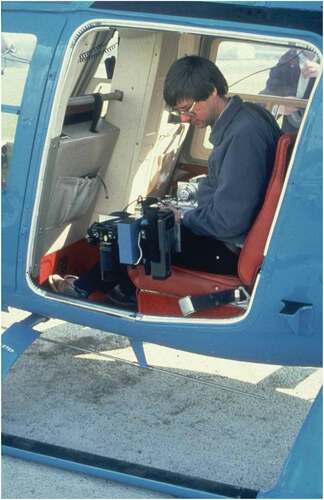
Ted and the EPFS team were major contributors to many airborne remote sensing campaigns throughout the 1990s and 2000s. One notable campaign in 2000, was the ‘Synthetic Aperture Radar and Hyperspectral Airborne Campaign’ (SHAC2000). Researchers from the EPFS, NERC’s Centre for Ecology and Hydrology, BAE Systems and InfoTerra, at fourteen field sites in England, Wales and Scotland, were supported with spectroscopic equipment loans and spectroscopic overflights by two aircraft. The state-of the art, spectroscopic and supporting data set was used subsequently in eleven research projects. Ted ensured that a key component of this campaign was the calibration and validation (‘cal/val’) of the remote sensing data products.
In 2003, Ted secured NERC funding to establish the Network for Calibration and Validation of Earth Observation data (NCAVEO). This project brought together twenty three partners from UK universities, the UK National Physical Laboratory (NPL) and Surrey Satellite Technology Ltd. This network was a testament to Ted’s innovative way of working and desire to collaborate across all sectors of the remote sensing community. As part of NCAVEO, a major field campaign was conducted in 2006, where the goal was to cross-calibrate various sensors in the laboratory, on the ground, and in the air (Milton Citation2008; ).
Figure 4. Ted (right), Tim Malthus (centre) and Andrew Wilson (left) cross-calibrating Microtops Sun photometers during the 2006 NCAVEO field campaign at the Chilbolton Facility for Atmospheric and Radio Research
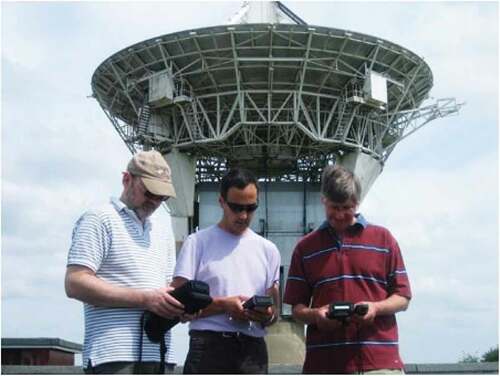
Later on, Ted worked closely with NPL colleagues to build and test spectroradiometric equipment. One project culminated in the construction of an innovative multi-angular spectro-goniometer called ‘GRASS’ (Pegrum et al. Citation2007). In another project, Ted designed and built an automated tramway system to carry a spectroradiometer that moved backwards and forwards and repeatedly measured the reflectance of calibration targets. This was built in sections at the Geography Department in Southampton, before being transferred to the Chilbolton Facility for Atmospheric and Radio Research, where it was installed. This gave Ted a few nervous moments while driving to deliver it, in a large lorry through the narrow country lanes near Chilbolton. Once installed, the tram was christened ‘Henry’ – after the steam locomotive of the same name in the Thomas the Tank Engine stories, who also ‘hid inside’ when it rained ().
Figure 5. Ted’s automated tramway system installed at the Chilbolton Facility for Atmospheric and Radio Research
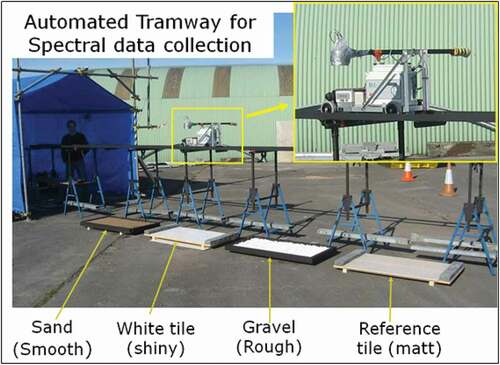
In 2009, Ted and a team of authors provided an updated perspective on field spectroscopy, which by then had become an established technique in remote sensing (Milton et al. Citation2009). This paper focused on describing more complex procedures such as goniometry for characterizing the bidirectional reflectance distribution function (BRDF) of surfaces. Central to this paper was the argument that spectroscopic data should be of ‘high quality, with stated levels of accuracy and uncertainty’ to ensure that data had ‘long-term value’ (Milton et al. Citation2009: S92). Crucially, this paper also highlighted that varying geometric measurement configurations (e.g. biconical, bihemispherical) could deliver different information about surface reflectance, and Ted highlighted the implications of this for remote sensing repeatability and reproducibility (Milton et al. Citation2009).
Ted was an inspirational lecturer and teacher, and he developed one of the first Geography undergraduate modules in applied remote sensing. In 1994, he received the Royal Society/Partnership Trust BP Exploration Prize for Innovation in Higher Education. He was awarded this prestigious award in part for a novel teaching aid, a folded-card slide rule containing cross-referenced information on the electromagnetic spectrum and remote sensing platforms and sensors. The aid was used in his undergraduate level courses and found to encourage learning and motivation (Milton Citation1994). Ted later held the role of programme leader for the EU Erasmus Mundus MSc in Geo-information Science and Earth Observation for Environmental Modelling and Management (GEM) at the University of Southampton between 2009–2014. In recognition of his contribution to the field of remote sensing, the best MSc dissertation prize for the applied GIS and Remote Sensing MSc programme at the University of Southampton is now named as the ‘Ted Milton prize.’
Ted was an excellent supervisor of students at all levels – from undergraduate to PhD – and is remembered as an empathetic academic who took the time to get to know his students. He was involved as part of the supervisory team on many interdisciplinary PhDs, and enthusiastically worked with the early Doctoral Training Centres. Many students remember him as a caring supervisor (e.g. he always remembered his students’ birthdays), who supported them fully, while still expecting them to perform at their best. Ted was a big proponent of women in science, providing unwavering support to female academics with young families, allowing them to work remotely at home long before this became accepted practice.
Ted was well-known for reusing and recycling a wide range of materials. For example, his use of old computer punched cards (left over from code he wrote during his PhD) as memos for notes. He used these regularly right up until his retirement (and at home), even at a time when most communication was done through email. His students regularly discovered hand written notes on these punched cards, left on top of their computer keyboard.
In 2011, Ted was awarded the Remote Sensing and Photogrammetry Society’s gold medal for his sustained and distinguished contribution to the techniques and applications of remote sensing. The award meant a great deal to Ted as it was recognition from his peers in the remote sensing community for his sustained contribution across many different areas of academic activity.
During his time at Southampton, Ted published more than 150 scientific and conference papers, and supervised more than 20 PhD students, several of whom now hold senior academic positions around the world. Ted retired in 2014, after 33 years at the University of Southampton. He was appointed as Professor Emeritus of Remote Sensing and remained active in remote sensing research and education. Throughout his retirement, Ted maintained an active interest in environmental sensing and continued building scientific instruments from consumer grade components and microcomputers. These projects included a highly sophisticated lightning detector, along with meteorological, air quality and solar radiation sensors which he deployed around his home and garden in Dorset. In the spirit of open science, Ted shared the designs and data from these projects on his personal website.
Ted will be remembered as a world-leading pioneer of field spectroscopy, a highly professional and rigorous Earth scientist, a wonderful colleague and a great friend.
Disclosure statement
No potential conflict of interest was reported by the author(s).
References
- Milton, E. J. 1980. “A Portable Multiband Radiometer for Ground Data Collection in Remote Sensing.” International Journal of Remote Sensing 1: 153–165. doi:https://doi.org/10.1080/01431168008547552.
- Milton, E. J. 1987. “Principles of Field Spectroscopy.” International Journal of Remote Sensing 8: 1807–1827. doi:https://doi.org/10.1080/01431168708954818.
- Milton, E. J. 1994. “A New Aid for Teaching the Physical Basis of Remote Sensing.” International Journal of Remote Sensing 15: 1141–1147. doi:https://doi.org/10.1080/01431169408954148.
- Milton, E. J. and the NCVEO Partnership (2008) The Network for Calibration and Validation in Earth Observation (NCAVEO) 2006 Field Campaign. In Proceedings of the Remote Sensing and Photogrammetry Society Conference: “Measuring Change in the Earth System.” University of Exeter, 15-17 September 2008. Remote Sensing & Photogrammetry Society. pp. 1–4.
- Milton, E. J., G. A. Blackburn, E. M. Rollin, and F. M. Danson. 1994. “Measurement of the Spectral Directional Reflectance of Forest Canopies: A Review of Methods and A Practical Application.” Remote Sensing Reviews 10: 285–308. doi:https://doi.org/10.1080/02757259409532251.
- Milton, E. J., M. E. Schaepman, K. Anderson, M. Kneubühler, and N. Fox. 2009. “Progress in Field Spectroscopy.” Remote Sensing of Environment 113: S92–S109. doi:https://doi.org/10.1016/j.rse.2007.08.001.
- Pegrum, H. M., N. Fox, E. Milton, and M. Chapman. 2007. “Development of the Gonio Radiometric Spectrometer System to Conduct Multi-angular Measurements of Terrestrial Surfaces.” Proceedings of the 10th International Symposium on Physical Measurements in Remote Sensing (ISPMSRS’07) 36 (Part 7): C50.
- Smith, G. M., and E. J. Milton. 1999. “The Use of the Empirical Line Method to Calibrate Remotely Sensed Data to Reflectance.” International Journal of Remote Sensing 20: 2653–2662. doi:https://doi.org/10.1080/014311699211994.

